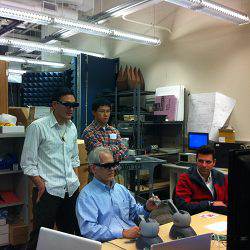
The leading commercial robotic surgical system — the daVinci by Intuitive Surgical — is reportedly in 2,000 hospitals and thousands of patients have been treated with it. But, because it is a closed system, it doesn’t lend itself to robotic research by academia.
That is why researchers have developed a new, open source robot — said to be the first of its kind — that is now facilitating robotic laparoscopic surgery research at seven different U.S. universities.
The universities are Harvard; Johns Hopkins; University of Nebraska-Lincoln; University of California, Berkeley; University of California, Los Angeles; University of California, Santa Cruz (UCSC); and University of Washington (UW).
Funded with a $1.1 million grant by the National Science Foundation, the Raven II‘s software supports the Robot Operating System, an open source robotics coding platform. Two sets of arms and two cameras allow collaborative surgery between a primary and an assistant surgeon [see video].
"The universities that are now using our robot are free to change the hardware and software in any way they would like and they retain the related IP [intellectual property]. If they would like to license that IP, that’s fine," says Jacob Rosen, an associate professor of computer engineering at the University of California-Santa Cruz and one of Raven II’s creators. "Their only obligation is to share the new code they’ve made with the rest of the community on the wiki site we’ve created in addition to our developer’s blog."
Rosen’s group at Santa Cruz’s bionics lab designed the robot’s mechanics while Blake Hannaford and his group designed the electronics and software. Hannaford is a professor of electrical engineering at the University of Washington and director of its biorobotics laboratory.
"In the past, each university had to start from scratch and patch their own robot together — no trivial matter," says Hannaford. "Or they’d buy some random robot from an assortment of vendors, which meant no lab could build on what others were doing since none of the robots were compatible. That’s been a real barrier to innovation."
While there have been other open-source robots — notably the PR2 from Willow Garage — "the PR2 is a service robot that’s good for doing laundry and housecleaning," says Hannaford. "It’s been very successful, but it’s not meant for doing surgery."
The Raven II is a revised version of the Raven I whose development began in the mid-1990s together with University of Washington surgeons Mika Sinanan and Tom Lendvay as part of a study aimed at developing mathematical algorithms for objectively assessing surgical skills. The researchers attached sensors to their surgical instruments and recorded the motions, creating a database of movements, forces, and torques that was then synthesized to enable a robot to perform the same actions.
Currently, several leading-edge Raven II projects are underway:
• At Harvard, engineers are working on beating-heart surgery during which a Raven II will compensate for the movement of a beating heart so the surgeon can operate as if on a static surface.
• At the University of California, Berkeley, machine learning software will monitor surgeons using the Raven II to perform various tasks. The software will then try to learn from the rules and algorithms that the surgeon uses to assess various situations and react accordingly.
• At the University of California-Santa Cruz, two pairs of Raven IIs are used to study collaborative surgery allowing two surgeons to operate on the same surgical site from two remote locations.
Rosen and Hannaford’s next efforts will involve the Raven III, an upgrade that four additional universities are negotiating to obtain.
"Our efforts will continue to involve helping the surgery profession create new and less-invasive cures," says Hannaford.
Paul Hyman is a science and technology writer based in Great Neck, NY.



Join the Discussion (0)
Become a Member or Sign In to Post a Comment